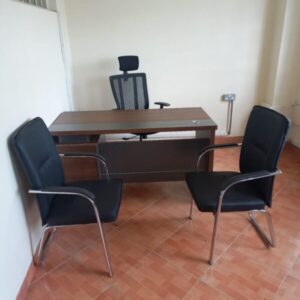Leather Visitors Chair
Original price was: KSh 12,000.00.KSh 9,000.00Current price is: KSh 9,000.00.
(In Stock)
A visitor’s chair is designed specifically for guests or visitors in an office setting. These chairs are typically placed in reception areas, meeting rooms, or across from an executive’s desk to provide comfortable and welcoming seating for short-term use. Here’s a detailed description:
1. Design and Structure:
- Standard Size: The chair is designed to be of a standard size that comfortably fits most adults. It usually has a slightly lower seat height compared to a standard office chair to promote relaxation and comfort during short visits.
- Simple and Elegant Design: The design of a visitor’s chair is often understated, blending well with the overall office decor. It is usually crafted to complement the existing furniture and décor of the office, offering a professional and cohesive look.
- Frame: The frame is typically made from metal, wood, or a combination of both, providing a sturdy base while also contributing to the aesthetic appeal.
2. Materials:
- Seat and Backrest Material: The seat and backrest are commonly upholstered in materials such as fabric, leather, faux leather, or mesh. These materials are chosen for their comfort, durability, and ease of maintenance.
- Padding: The seat and backrest are usually padded with high-density foam or similar materials to provide a comfortable seating experience, even if the visit extends beyond a few minutes.
- Frame Material: The frame of the chair can be made from various materials, including:
- Metal: Often used for a modern look, metal frames are durable and can come in finishes like chrome, matte black, or brushed aluminum.
- Wood: Wood frames offer a classic and warm aesthetic, often finished with varnish or paint to match the office’s decor.
3. Comfort and Ergonomics:
- Ergonomic Support: While not as elaborate as a task or executive chair, a visitor’s chair still provides basic ergonomic support. The backrest typically has a slight curve to support the natural shape of the spine, and the seat may be slightly contoured for added comfort.
- Armrests: Many visitor chairs include armrests for additional comfort. These may be padded or left as exposed wood or metal, depending on the design.
- Seat Height: The seat height is often fixed and is designed to be comfortable for a wide range of users. The chair may have a slight recline or tilt to encourage a relaxed sitting posture.
4. Stability and Durability:
- Fixed Base: Visitor chairs typically have a fixed base, which might be four legs, a cantilever (sled) base, or a single pedestal base. This design ensures stability and prevents tipping.
- Non-Slip Feet: The legs often have rubber or plastic caps to prevent slipping on hard floors and to protect the flooring from scratches.
5. Style and Aesthetics:
- Variety of Styles: Visitor chairs come in various styles, ranging from contemporary and minimalist designs with clean lines and neutral colors to more traditional styles with ornate woodwork or leather upholstery.
- Color Options: Available in a range of colors, visitor chairs can be chosen to match the office’s color scheme. Neutral tones like black, gray, beige, and brown are common, but more vibrant colors can also be selected to make a statement or match a company’s branding.
- Finish: The finish of the chair’s frame (metal or wood) can significantly influence its overall appearance. Metal finishes might include polished chrome, matte black, or brushed steel, while wood finishes can range from light oak to dark mahogany.
6. Functionality:
- Non-Swivel Design: Unlike office task chairs, visitor chairs usually do not swivel. This is to encourage a more formal and stationary seating posture, appropriate for meetings and brief interactions.
- Lightweight: Visitor chairs are generally lightweight, making them easy to move around and rearrange within a room as needed.
7. Applications:
- Reception Areas: These chairs are commonly placed in reception or waiting areas to provide comfortable seating for visitors as they wait.
- Meeting Rooms: Visitor chairs are often used in meeting rooms or conference areas, where they provide seating for clients, partners, or other guests during discussions.
- Executive Offices: In executive offices, visitor chairs are placed across from the desk for meetings with clients, colleagues, or guests.
8. Customization:
- Personalization: Many visitor chairs can be customized with different upholstery materials, colors, and frame finishes to suit specific office environments. Custom branding options, such as embroidered logos, may also be available.
- Optional Features: Some chairs offer additional features like extra padding, ergonomic adjustments, or matching side tables.
9. Maintenance:
- Easy to Clean: Visitor chairs are often designed with easy-to-clean materials, which is particularly important in high-traffic areas. Leather and faux leather can be wiped down, while fabric upholstery might be treated to resist stains.
- Durability: Built to last, these chairs are constructed to withstand regular use by multiple people, with durable materials and finishes that resist wear and tear.
An office visitor’s chair is a versatile, comfortable, and stylish seating option that enhances the guest experience in a professional setting, offering both form and function while fitting seamlessly into the office environment.









Reviews
There are no reviews yet.